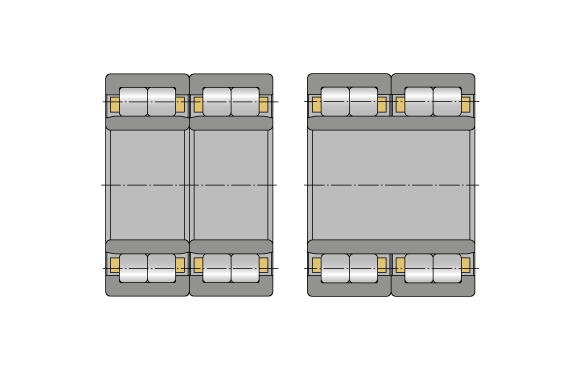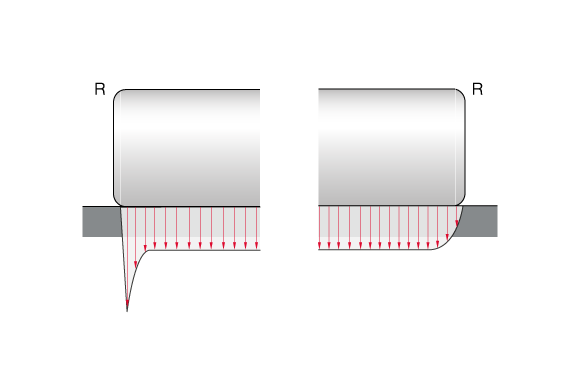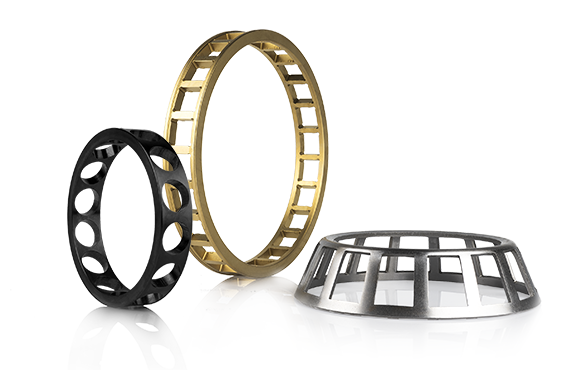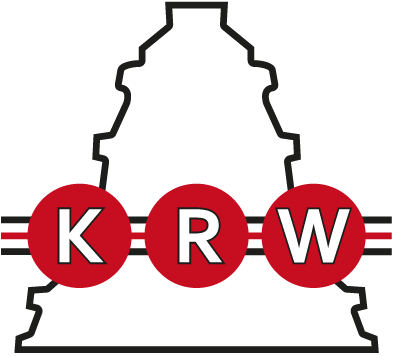
Cylindrical Roller Bearings
multi row, with cage
- Absorption of very high radial loads
- Precise shaft guidance with high rigidity
- Inner and outer rings with roller cage assembly available separately

Multi row cylindrical roller bearings with cage can absorb extremely high radial forces due to the linear contact between rolling element and bearing ring and the high number of rolling elements. They are classified into two general designs which differ in separation of the inner ring. Multi row cylindrical roller bearings can be disassembled and are easily installed or uninstalled. They are suitable for high speeds, but they cannot compensate angular misalignments.
Dimensions and Tolerances
KRW supplies multi row cylindrical roller bearings with normal tolerance (PN) in accordance to DIN 620-2 (Tolerances for roller bearings) and ISO 492 (Radial bearings - Dimensional and geometrical tolerances). All other deviating or special tolerances must be specified with the order.

Multi row cylindrical roller bearing types NNU60 (left) and NU60 (right)
Bearing Design
Multi row cylindrical roller bearings with cage are dismountable and non-latching bearings that KRW divides into the bearing types NU60 and NNU60. Both types are equipped with four bearing rows which are guided through four solid flanges on two outer rings. The NNU60 bearings have two inner rings without flanges while the NU60 bearings have one inner ring without flanges.
Multi row cylindrical roller bearings with cage are suitable for the absorption of extremely high radial forces and offer especially high rigidity. Cylindrical roller bearings can be delivered with cylindrical or tapered bore.

The missing flange on the inner ring facilitates shaft clearance in axial direction of the housing and lets the bearing function as floating bearing. The compensation of linear expansion occurs unrestrained in the bearing so a sliding fit in the housing or on the shaft is not necessary. Additional or deviating designs are available on request or custom-designed. Due to the logarithmic profiling of the cylindrical rollers, damaging edge tension and resulting premature failures are avoided.
Bearing Clearance
KRW supplies multi row cylindrical roller bearings in normal clearance (CN) in accordance with DIN 620-4 (Rolling bearing tolerances) and ISO 5753-1 (Rolling bearings - Internal clearance), but they are also available in all clearance classes with restricted clearance or special clearance. Bearing components with a standardised bearing type with identical standard clearance are interchangeable with each other. For clearance classes smaller than CN or restricted clearance classes, an interchange of bearing components is no longer possible because the components must be compatible.
| ||||||||

Cage
Cylindrical roller bearings by KRW are equipped with a roller-riding solid brass cage (suffix: M). Other cage designs, e.g. pin type cages, are available on request or chosen for specific applications and labelled accordingly on the bearing.
Suffixes
Compensation of Angular Misalignments
Multi row cylindrical roller bearings are not suitable for compensation of misalignments. Misalignments cause edge stresses between rolling elements and raceways and produce additional stresses in the bearing which reduce its operating life.
Speed
The kinematic limiting speed nG is a practical mechanical limit value and is based on the mechanical fatigue strength of the rolling bearing as a function of its installation situation and lubrication. The limit speed must not be exceeded even under optimum operating conditions without prior consultation with KRW.
The DIN ISO 15312 (Rolling bearings - Thermal speed rating) does not specify a thermal speed rating nth for these bearings.
Admissible Operating Temperatures
The admissible operating temperature of a bearing is limited by cage material, dimensional stability of the bearing components (ball race and rolling elements), as well as lubrication. By default, KRW bearings are stabilised up to 200°C (S1). KRW provides roller bearings for higher operating temperatures on request.
Dimensioning
For dynamically loaded bearings
The service life formula according to ISO 281 L10 = (C/P)p for dynamically loaded bearings requires an equivalent load (P) from constant direction and size. To calculate P, calculation factors and the ratio of axial and radial load are required. This is shown in the following equations.
Equivalent Dynamic Bearing Load P
For a purely radially loaded cylindrical roller bearing acting as a floating bearing, the following applies:

| P | equivalent dynamic load | [kN] |
| Fr | dynamic radial force | [kN] |
For statically loaded bearings
Dynamic dimensioning loses its validity for bearings rotating at very low speeds (n x dm ≤ 4000 mm/min). The static load safety factor S0 is calculated as follows:

| S0 | static load safety factor | [-] |
| C0 | static load rating (from bearing chart) | [kN] |
| P0 | equivalent static bearing load | [kN] |
| n | Speed | [min-1] |
| dm | mean bearing diameter [dm = (D+d)/2] | [mm] |
Static load capacity

Minimum Radial Load
A minimum load is required for the reliable operation of a rolling bearing. If the minimum load is not reached, slippage may occur. The minimum radial load for cylindrical roller bearings is roughly assumed to be 1.67% of the static load rating C0 of the bearing. If the value falls below this value, please consult KRW Application Technology.



